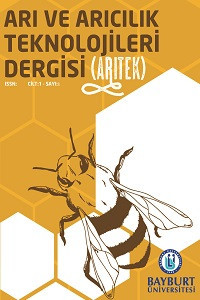ARDAHAN'DA ARICILARIN VE ARICILIK İŞLETMELERİNİN YAPISAL DURUMU
Beekeeping, Arıcılık, işletme, balarısı, gezginci ve sabit arıcı
STRUCTURAL STATUS OF BEEKEEPERS AND BEEKEEPING ENTERPRISES IN ARDAHAN
Beekeeping, enterprise, honeybee, migratory and settled beekepers,
___
- Adl, M. B. F. and Gençer, H. ve Firatli, Ç. ve Bahreini, R. (2007). "Morphometric characterization of Iranian (Apis mellifera meda), Central Anatolian (Apis mellifera anatoliaca) and Caucasian (Apis mellifera caucasica) honey bee populations”, Journal of Apicultural Research, 46(4), S. 225-231.
- Anonim (2018). Erişim adresi: www.serka.gov.tr/store/file/common/f4fb1a6282d86518e625f3b910ace682.pdfttESK Cengiz, M. M. ve Genç, F. (1999). “Erzurum’da arıcıların ve arıcılık işletmelerinin nitelikleri [Qualifications of beekeepers and beekeeping enterprises in Erzurum]”, Türkiye’de Arıcılığın Sorunları ve I.Ulusal Arıcılık Sempozyumu, S. 210-221, 28-30 Eylül 1999, Kemaliye Erzincan.
- Cengiz, M. M. ve Dülger, C. (2018). “Determining the some physiological characteristic of honey bee (Apis mellifera L.) colonies established by controlled reared queens in migratory and stationary beekeeping conditions”, Atatürk Üniversitesi Veteriner Bilimleri Dergisi, 1, S. 19-27.
- Cochran, W. G. (1977). Sampling Techniques, 3rd Edition, New York: John Wiley and Sons.
- Çelik, H. (1994). “Kalecik İlçesinde Gezginci Arıcıların Sorunları ve Arıcılıkla Yararlanılan Bilgi Kaynakları Üzerine Bir Araştırma”, Basılmamış Yüksek Lisans Tezi, Ankara Üniversitesi, Fen Bilimleri Enstitüsü, Ankara.
- Çiçek, A. ve Yücer, A. A. (1993). “Tokat ilinde arıcılığın yeri, ekonomik önemi ve sorunları üzerine bir araştırma”, Gaziosmanpaşa Üniversitesi Ziraat Fakültesi Dergisi, 1, S. 50-160.
- Demen, H. ve Karacoğlu M. ve Uçak, K. A. (2016). “Diyarbakır ili arıcılığın yapısı ve sorunları”, Tralleis Elektronik Dergisi, 1, S. 8-17.
- Genç, F. ve Dodoloğlu, A. (2017). “Arıcılığın temel esasları”, Atatürk Üniversitesi Ziraat Fakültesi Yayınları, Yayın No:341, Atatürk Üniv. Zir. Fakültesi Ofset Tesisi, Erzurum, S. 467.
- Kadirhanoğulları, İ. H. (2016). “Iğdır ili arıcılarının sosyo-ekonomik durumu”, Uludağ Arıcılık Dergisi, 16(1), S. 2 - 11.
- Kaftanoğlu, O. ve Kumova, U. ve Yeninar, H. ve Özkök, D. (1995). “Türkiye’de balarısı (Apis mellifera L.) hastalıklarının dağılımı, koloniler üzerine etkileri ve entegre kontrol yöntemlerinin uygulanması”, Türkiye Bilimsel ve Teknik Araştırma Kurumu Veterinerlik ve Hayvancılık Araştırma Grubu Proje No: VHAG-925, Kesin Sonuç Raporu, Ankara.
- Kumova, U. ve Özkütük, K. (1988). “Çukurova bölgesinde arı yetiştiriciliğinin yapısı”, Ç.Ü. Ziraat Fakültesi Dergisi, 3(1), S. 26-40.
- Kuvancı, A. ve Yılmaz, F. ve Öztürk, S. H. ve Konak, F. ve Buldağ, M. (2017). “Doğu Karadeniz bölgesi arıcılığına genel bakış”, Arıcılık Araştırma Dergisi, 9(2), S. 47-55.
- Önk, K. ve Cengiz, M. M. ve Yazıcı, K. ve Kırmızıbayrak, T. (2016). “Effects of rearing periods on some reproductive characteristics of caucasian (Apis mellifera caucasica) queen bees”, Atatürk Üniversitesi Veteriner Bilimleri Dergisi, 11(3), S. 259-266.
- Özbakır G Ö, Doğan Z & Öztokmak A (2016). “Adıyaman ili arıcılık faaliyetlerinin incelenmesi”, Harran Tarım ve Gıda Bilimleri Dergisi, 20(2), S. 119-126.
- Özhatay, N. ve Eminağaoğlu, Ö. ve Esen, S. (2010). “Karlı yaylaların saklı bahçesi-Ardahan’ın doğal bitkileri”, Promat A.Ş., İstanbul, S. 128.
- TUİK (2018). Türkiye’nin Hayvan Varlığı ve Hayvansal Üretim Verileri, Türkiye İstatistik Kurumu Verileri, Erişim adresi: www.tuik.gov.tr, 7 Şubat 2018.
- Yamane, T. (2006). Temel Örnekleme Yöntemleri, Çev. Esin, A. ve Bakır, M. A. ve Aydın, C. ve Güzbüzsel, E. İstanbul: Literatür Yayınları: 53.
- Yıldız, N. ve Bircan, H. (2006). Uygulamalı İstatistik, Ankara: Nobel Yayın Dağıtım.
- Yayıncı: Bayburt Üniversitesi
TÜRKİYE ARICILIĞINDA VERİM DÜŞÜKLÜĞÜNÜN SEBEPLERİ
Ahmet DODOLOĞLU, Yaşar ERDOĞAN
POLEN BİLEŞENLERİNİN KALİTE STANDARTLARI AÇISINDAN İNCELENMESİ
ARDAHAN'DA ARICILARIN VE ARICILIK İŞLETMELERİNİN YAPISAL DURUMU
Mahir Murat CENGİZ, Abdulkerim DİLER, Kemal YAZICI
RAKIM FARKININ BALLARIN BAZI KİMYASAL ÖZELLİKLERİ ÜZERİNE ETKİSİ
